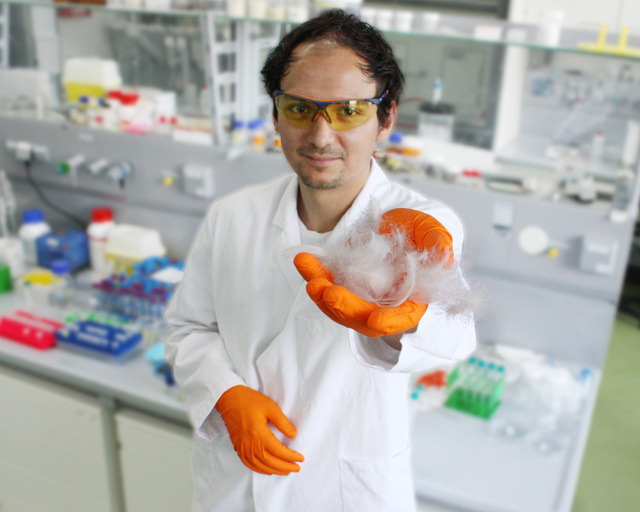The Fraunhofer IAP expands research spectrum
Novel biomaterials from proteins
For nearly 25 years, biomaterials from renewable raw material have been a priority field of research at the Fraunhofer-Institute for Applied Polymer Research IAP in Potsdam-Golm. Research to date has focused on plant-based raw materials such as cellulose, starch, and lignin. Now the researchers are also developing biomaterials from proteins. Two new departments are involved with this field.
Safely preserving plastic wrap
“Function Integrated Polymer Films” are the focus of the newly established department of the same name at the Fraunhofer IAP. Under the direction of Dr. Murat Tutuş, this department started expanding the Fraunhofer IAP’s research spectrum in July 2016. Plastic wrap used for packaging fresh foods like cheese is one of the research focuses. “We coat films with natural proteins that have a preserving effect on the food surface. The best thing about it is that the natural preservative does not get into the food and it, thus, remains pure, which is important given the declining customer acceptance of preservatives,” Tutuş explains. Through the Fraunhofer IAP’s versatile competencies, the research team wants to develop products “completely in-house”. In the future, biobased films developed at the Fraunhofer IAP will be coated. The IAP’s expert knowledge of surface technologies and in-house biotechnology will be utilized as well. “We will use the coating system to develop strips that indicate the freshness of food and can verify that the cold chain was maintained,” says Tutuş. Other key activities of the department include developing and examining functionalized membranes and new membrane materials and films.
Abattoir refuse as raw material – New materials from keratin
The use of keratin from abattoir refuse is a topic in the department “Functional Protein Systems/Biotechnology” headed by Fraunhofer IAP director Prof. Alexander Böker. Keratin is a structural protein that does more than just give shape to our hair. It is also a component of beaks, hooves, fur, and feathers. “Such animal residues are normally combusted or processed into animal feed. We want to make the keratin in abattoir refuse usable by developing materials from it. Feathers are particularly suitable because they are up to 90 percent keratin and have a very clearly defined composition, explains Dr. Ruben Rosencrantz, a researcher on Böker’s team. Keratin can, for example, remove formaldehyde from room air, making it a suitable filter material for refurbishing buildings compromised by formaldehyde. It can also bind heavy metals.
Keratin has not yet been used as a basis for a material. Industrially, the structural protein has been used, for example, as a shampoo additive in the form of a hydrolysate. For about a year, Prof. Böker and his research team have been developing, among other things, regenerated fibers from keratin. “We want to leave the protein intact to retain the material properties. We are currently investigating suitable procedures to make keratin spinnable,” says Rosencrantz. At the institute’s spinning line, the researchers can draw on the extensive long-term experience of the Fraunhofer IAP in biobased fibers made from cellulose.
Last modified:
